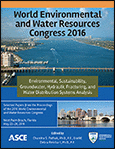Chapter
May 18, 2016
Physical and Numerical Modeling of Unstable Flow Due to Heavier Saltwater Overlying Freshwater
Authors: Kamal Mamoua [email protected], Ashok Pandit [email protected], Howell H. Heck [email protected], Diogo S. A. Araujo [email protected], and Antonio Berber [email protected]Author Affiliations
Publication: World Environmental and Water Resources Congress 2016
Abstract
It is well-known that unstable flows occur when denser saltwater overlies lighter freshwater. One such situation occurs in the Indian River Lagoon (IRL), a coastal estuary, located on the east coast of Florida. The IRL water is brackish as it is a mixture of the saltwater from the Atlantic Ocean flowing through inlets and the freshwater flowing from canals, rivers and groundwater. This brackish water overlies the freshwater that flows in the unconfined aquifer below the IRL. All cases of unstable density stratification result in a rapid and erratic redistribution of the salt. The rate of salt movement is much different than predicted by ordinary molecular diffusion alone. The dynamics of this unstable flow was investigated using a physical model made of Plexiglas which is 1.83m high and has a base of 0.61m by 0.61m. The model was filled with 1.64m of sand and the part above the sand, the source area, was used to add seawater or brackish water. The model consisting of five ports located at 0.255, 0.560, 0.865, 1.170, and 1.474m from the source was filled with 40F sand which was saturated with freshwater. This paper shows breakthrough curves from two experiments, conducted over five days and over 28 days in which the source concentration was kept constant at 36,000 mg/L at a depth of 4.5cm. Results indicate that the flow was unstable in the beginning (did not yield smooth breakthrough curves) but stabilized after approximately 23 days. Measured breakthrough curves were compared with numerically simulated curves using SEAWAT. It was found that the salt concentrations, under unstable conditions, can be predicted with reasonable accuracy if (1) the selected molecular diffusion coefficients are several orders of magnitude higher than values obtained through traditional experiments and (2) the selected molecular diffusion coefficients are time-dependent.
Get full access to this chapter
View all available purchase options and get full access to this chapter.
Information & Authors
Information
Published In
Copyright
© 2016 American Society of Civil Engineers.
History
Published online: May 18, 2016
Permissions
Request permissions for this article.
Authors
Affiliations
Doctoral Student, Dept. of Civil Engineering, Florida Institute of Technology, W. University Blvd., 32901 Melbourne, FL. E-mail: [email protected]
Professor and Department Head, Dept. of Civil Engineering, Florida Institute of Technology, W. University Blvd., 32901 Melbourne, FL. E-mail: [email protected]
Associate Professor, Dept. of Civil Engineering, Florida Institute of Technology, W. University Blvd., 32901 Melbourne, FL. E-mail: [email protected]
Undergraduate Student, Dept. of Civil Engineering, Florida Institute of Technology, W. University Blvd., 32901 Melbourne, FL. E-mail: [email protected]
Graduate Student, Dept. of Civil Engineering, Florida Institute of Technology, W. University Blvd., 32901 Melbourne, FL. E-mail: [email protected]
Metrics & Citations
Metrics
Citations
Download citation
If you have the appropriate software installed, you can download article citation data to the citation manager of your choice. Simply select your manager software from the list below and click Download.
View Options
Get Access
Access content
Please select your options to get access
Log in/Register
Log in via your institution (Shibboleth)
ASCE Members:
Please log in to see member pricing
Purchase
Save for later Item saved, go to cart Information on ASCE Library Cards
ASCE Library Cards let you download journal articles, proceedings papers, and available book chapters across the entire ASCE Library platform. ASCE Library Cards remain active for 24 months or until all downloads are used. Note: This content will be debited as one download at time of checkout.
Terms of Use: ASCE Library Cards are for individual, personal use only. Reselling, republishing, or forwarding the materials to libraries or reading rooms is prohibited.
Terms of Use: ASCE Library Cards are for individual, personal use only. Reselling, republishing, or forwarding the materials to libraries or reading rooms is prohibited.
Get Access
Access content
Please select your options to get access
Log in/Register
Log in via your institution (Shibboleth)
ASCE Members:
Please log in to see member pricing
Purchase
Save for later Item saved, go to cart Information on ASCE Library Cards
ASCE Library Cards let you download journal articles, proceedings papers, and available book chapters across the entire ASCE Library platform. ASCE Library Cards remain active for 24 months or until all downloads are used. Note: This content will be debited as one download at time of checkout.
Terms of Use: ASCE Library Cards are for individual, personal use only. Reselling, republishing, or forwarding the materials to libraries or reading rooms is prohibited.
Terms of Use: ASCE Library Cards are for individual, personal use only. Reselling, republishing, or forwarding the materials to libraries or reading rooms is prohibited.
